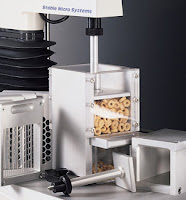In Germany, where cereals face stiff competition from traditional breakfast foods, the emphasis is shifting towards the promotion of cereals as a quick pick-me-up, as meals become lighter and less stodgy. In the Mediterranean countries of Spain, Italy and France, where a late evening meal is the cultural norm, cereals are being promoted as a substantial after-school snack for children.
In this competitive market, companies are battling for market share and constantly looking at new product introductions and improvements to traditional favourites. New product introductions may target specific segments of consumers – young and old – or ride on current trends, whether its health consciousness, the latest action figure or some other ingredient or formulation improvement that will gain interest by its promotion.
Breakfast cereals, like many other snack products, are also manufactured as crisp products which must be kept in that form for the maximum enjoyment of the consumers. However, they are different in their structural form due to the manner in which they are consumed. In the traditional method, the breakfast cereals are mixed with milk and are consumed over a period of a few minutes. The diffusion of water into the structure causes a softening of the crisp texture, but if this occurs too quickly the breakfast cereal becomes soft and loses its appeal.
 |
| A bulk compression test on breakfast cereal pieces using an Ottawa cell |
Breakfast cereals, such as cornflakes, represent a remarkably non-uniform configuration from piece to piece (flake to flake) and therefore the testing of one flake at a time is often meaningless. Fracture itself represents a very difficult characteristic to measure due to the fact that a fracture event never occurs the same a second time. A convenient physical test is to compress a population of cereal flakes constrained within a container such as the Ottawa cell which attaches to a TA.HDplus or TA.XTplus Texture Analyser.
In such a test the multi-peak jagged curves obtained will result from the fracture of a number of flakes/pieces, each peak corresponding to the rupture of a single flake/piece. This is different from the situation where a single piece of highly expanded extrudate is being compressed. However, it offers an averaging effect test of a more representative portion of the sample which is much more repeatable. The multi peak curves obtained may then be analysed using special calculations.
 |
| Typical curve of a bulk compression test of a breakfast cereal/ potato crisp portion |
Bowl Life Determination
Of particular industrial interest is the change in “crispness” as a product hydrates. Breakfast cereals are prone to staling over time and become soggy if left in liquid for too long. A Bowl Life test aims to provide manufacturers with a method of measuring crispiness, which is a good indicator of the cereal freshness.
In an Ottawa Cell, flakes are compressed with a flat plunger. The Cell is unique as it has a watertight base, allowing the immersion of the cereal in a liquid, which can then be drained to allow testing to begin immediately. This procedure reduces the likelihood of results being affected by sample disturbance and a delay in the commencement of the test due to sample transfer. As compression proceeds fracturing can be observed as a series of force peaks. The maximum force value is considered to be an indication of the overall 'hardness' of the sample and the linear distance is considered as an indication of 'crispness'. The greater the linear distance, the crisper the product.
|
Additional Special Multi-peak Curve Calculations in Exponent
 |
| Typical force-time curve displaying a zoomed section of curve to which the curve best fit function has been applied |
Special calculations include the ability to measure parameters such as: Drop Off; Linear Distance; Curve Best Fit; Dispersion; Average Gradient; and Smooth Line.
The above are all calculated from a single click movement and take less than a second to produce results which are automatically dropped into a spreadsheet making the analysis of crispness quick and simple.
Request our article The Sound of Quality for Food which looks at developments in the field of food acoustics.
For more information on how to measure texture, please visit the Texture Analysis Properties section on our website.
 The TA.XTplus texture analyser is part of a family of texture analysis instruments and equipment from Stable Micro Systems. An extensive portfolio of specialist attachments is
available to measure and analyse the textural properties of a huge range of
food products. Our technical experts
can also custom design instrument fixtures according to individual
specifications.
The TA.XTplus texture analyser is part of a family of texture analysis instruments and equipment from Stable Micro Systems. An extensive portfolio of specialist attachments is
available to measure and analyse the textural properties of a huge range of
food products. Our technical experts
can also custom design instrument fixtures according to individual
specifications.No-one understands texture analysis like we do!
To discuss your specific test requirements, click here...
|








No comments:
Post a Comment